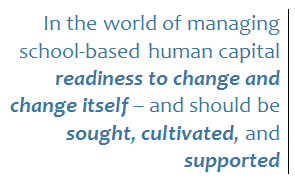In the world of R&D, the concept of absorptive capacity drives thinking around companies’ innovation capabilities. Cohen and Levinthal (1990) originally defined absorptive capacity as a company’s “ability to recognize the value of new information, assimilate it, and apply it to commercial ends.” Zahra and George (2002) further refined the definition to “a set of organizational routines and processes by which firms acquire, assimilate, transform, and exploit knowledge to produce a dynamic organizational capacity.”
WAIT, DON’T GO! This is NOT another blog about how schools are or aren’t like companies! Please read on.
Good teachers innovate in their classrooms all the time: they take prior knowledge about students, pedagogy, and content; they assimilate new data about students, new best practices, and curricula; and they combine the two in a transformative way to produce new results, new gains, and new, bigger, better outcomes for their kids.
 Excellent school leaders understand that supporting this capacity for transformation means devoting trust and resources to their teachers so that they can, essentially, have their own classroom-based R&D labs. Zahra and George further break down absorptive capacity into potential (ready to assimilate new knowledge) versus realized (gaining new benefit from that knowledge). A dry sponge has potential absorptive capacity (it knows how to absorb and the user knows how to use it). A damp sponge can realize its absorptive capacity (it absorbs, able to change itself and its surroundings). In the world of managing school-based human capital, these same capacities – readiness to change and change itself – and should be sought, cultivated, and supported.
Excellent school leaders understand that supporting this capacity for transformation means devoting trust and resources to their teachers so that they can, essentially, have their own classroom-based R&D labs. Zahra and George further break down absorptive capacity into potential (ready to assimilate new knowledge) versus realized (gaining new benefit from that knowledge). A dry sponge has potential absorptive capacity (it knows how to absorb and the user knows how to use it). A damp sponge can realize its absorptive capacity (it absorbs, able to change itself and its surroundings). In the world of managing school-based human capital, these same capacities – readiness to change and change itself – and should be sought, cultivated, and supported.
A teaching staff with strong potential absorptive capacity possesses masterful prior knowledge of content, pedagogy, students, and the myriad artful human interactions that come into play when teaching the whole child. Teachers’ potential must also include receptivity to new information – new assessment data, new tools and practices, even new information on what’s affecting students’ lives day-to-day. These high-quality teachers are so masterful of their prior knowledge, they can’t help but be open to all this new knowledge because they know it is only through this assimilation of old and new that they’ll push their entire classroom’s performance forward.
From a school-based human capital perspective, realized absorptive capacity is the ability to transform – it’s the ability not only to add new knowledge to prior knowledge, resulting in a gain for a student, it’s the ability to create a dynamic school-wide atmosphere that allows for the same exponentially innovative behavior that a Fortune 100 company R&D laboratory possesses. The outcomes of these classrooms and laboratories create changes that improve countless lives.
In order to realize the full potential of the people in your organization, school leaders and board members must dampen the sponge by:
• hiring good people in the first place,
• encouraging them to build a culture of powerful learning through well-researched experimentation and, yes, even failure (without punishment),
• supporting spoken priorities around innovative behaviors with thoughtfully chosen resources,
• communicating through open and effective channels across all planes of the school, and
• structuring the school-day and -year to demonstrate the recognition that the future of your students depends on your in-house R&D.
Is your sponge ready?

